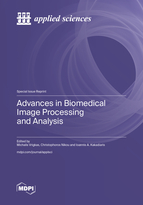Advances in Biomedical Image Processing and Analysis
A special issue of Applied Sciences (ISSN 2076-3417). This special issue belongs to the section "Applied Biosciences and Bioengineering".
Deadline for manuscript submissions: closed (30 June 2023) | Viewed by 24183
Special Issue Editors
Interests: image processing; machine learning; computer vision; biomedical imaging; augmented/virtual reality
Special Issues, Collections and Topics in MDPI journals
Interests: image processing and analysis; computer vision; pattern recognition; with emphasis on biomedical applications
Special Issues, Collections and Topics in MDPI journals
Special Issue Information
Dear Colleagues,
Biomedical image analysis plays a vital role in diagnosing numerous pathologies, ranging from infectious diseases to cancer. Advanced methodologies for signal and/or image processing and analysis and biomedical analytics may be a powerful tool for classifying medical data, identifying individualized health trends, and finding evolutionary trajectories between normal and non-normal cases in many medical applications.
The rapid growth in algorithms and computing power in recent years has spurred the emergence of machine learning and image processing techniques as a new tool, which is rapidly entering every aspect of our lives, from intelligent personal assistance, such as Siri, Alexa, and Google Home, to self-driving cars. The medical community has begun taking advantage of these new possibilities to create new predictive models and improve existing models. For example, novel methods applying machine learning and image processing/analysis methods that are robust and theoretically sound to efficiently and intuitively solve learning tasks have become widespread across different facets of biomedical imaging for identifying complex patterns. Likewise, advances in biomedical imaging may lead to new technologies for developing predictive models for all diseases and guide the decision on who should receive preventive therapy.
To incorporate different aspects of health monitoring, authors are invited to submit papers reporting novel imaging methods with biomedical applications—in particular, exploration and research into the development of new algorithms for biomedical image processing and analysis—to this Special Issue. Topics of interest include, but are not limited to, the following:
- Computer-aided diagnosis;
- Imaging biomarkers;
- Image reconstruction;
- Image registration;
- Image segmentation;
- Integration of imaging with non-imaging biomarkers;
- Interpretability and explainability of machine learning;
- Machine learning for biomedical applications;
- Advances in machine learning methods;
- COVID-19 and imaging;
- Biomedical and biological image processing;
- Deep learning for biomedical imaging;
- Histopathological image analysis;
- Mixed, augmented, and virtual reality;
- Visualization in biomedical imaging.
Articles and reviews are also welcomed.
Dr. Michalis Vrigkas
Prof. Dr. Christophoros Nikou
Dr. Ioannis A. Kakadiaris
Guest Editors
Manuscript Submission Information
Manuscripts should be submitted online at www.mdpi.com by registering and logging in to this website. Once you are registered, click here to go to the submission form. Manuscripts can be submitted until the deadline. All submissions that pass pre-check are peer-reviewed. Accepted papers will be published continuously in the journal (as soon as accepted) and will be listed together on the special issue website. Research articles, review articles as well as short communications are invited. For planned papers, a title and short abstract (about 100 words) can be sent to the Editorial Office for announcement on this website.
Submitted manuscripts should not have been published previously, nor be under consideration for publication elsewhere (except conference proceedings papers). All manuscripts are thoroughly refereed through a single-blind peer-review process. A guide for authors and other relevant information for submission of manuscripts is available on the Instructions for Authors page. Applied Sciences is an international peer-reviewed open access semimonthly journal published by MDPI.
Please visit the Instructions for Authors page before submitting a manuscript. The Article Processing Charge (APC) for publication in this open access journal is 2400 CHF (Swiss Francs). Submitted papers should be well formatted and use good English. Authors may use MDPI's English editing service prior to publication or during author revisions.
Keywords
- biomedical image processing
- biomedical image analysis
- biomedical imaging
- machine learning
- deep learning
- biomedical imaging
- mixed augmented, and virtual reality








